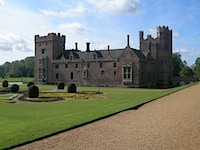Romantic, quirky moated manor house with Catholic connections.
Oxburgh Hall, near Swaffham in Norfolk, is an excellent example of the change in building style in the fifteenth century, from fortress to family home. Built in 1482, and held by the Bedingfeld family for over five hundred years.
There's no doubt that Oxburgh Hall is a romantic building. It looks like the perfect place to fall in love and to wander around, hand in hand with your sweetheart. But although the Hall is picturesque, it's not exactly 'of a piece'. Instead, it's grown into what you see today, over a long history, with varieties of architectural styles being added on - and taken off. The overall effect might not be entirely convincing, but there's no denying it has charm.
What faces you when you arrive at Oxburgh is an unusual square moat, with sides 75m in length, on which sits a house with four different faces.
The first buildings at Oxburgh Hall were built in 1482 by Sir Edmund Bedingfeld. Sir Edmund had backed the winning side in the Wars of the Roses and his family did well through the difficult years of the late fifteenth century. He was sensible enough to throw in his lot with the victor of the Battle of Bosworth, Henry VII, who visited Oxburgh with his wife Elizabeth of York in 1487, two years after he won the throne from Richard III. The rooms where they lodged in the Gatehouse are preserved today.
You enter the Hall over the bridge and under the imposing, seven tiered, gatehouse, which rises to over 80ft in height. This is the star feature of Oxburgh. You can climb to the top of the tower for marvellous views all around. Although technically fortified, the gatehouse has never really been intended as a stronghold, instead it demonstrates the way in which English landowners gradually adapted the style of their properties, from genuine fortresses to comfortable family homes. The towers were always more symbolic than functional.
At the Reformation, the Bedingfeld family remained strong adherents of Catholicism. Sir Henry Bedingfeld {1509 -1583), was one of the key players in having Mary proclaimed queen on the death of her brother Edward VI. Under her reign, Sir Henry became Constable of the Tower of London, and was given responsibility for guarding the Princess Elizabeth at Woodstock Palace after the threat from the Wyatt conspiracy. Historic novels are fond of portraying Sir Henry as a cruel gaoler, but this may not be true, in fact after her accession in 1559, Elizabeth I seems to have been quite considerate to Sir Henry, hardly likely had she felt animosity towards him.
Despite his relationship with the queen, being a Catholic was to cause Henry and his family difficulties over the next two hundred years, when practicing Catholicism attracted considerable restrictions and costs. To protect visiting priests from being discovered, a 'priest's hiding hole' was built in the gatehouse. It's still there today, and if you're small and brave enough, you can get inside, for a real experience of what it was like to be a hunted priest in Elizabethan England.
Other attractions at the Hall are needle-workings made during her captivity, by the ill-fated Mary Queen of Scots and her long-term gaoler's wife, Bess of Hardwick. I love seeing old needle work, it somehow gives me a very close connection with the women who created them, perhaps because it's one of my favourite pastimes too. When you're sewing, your mind can roam free. I always wander what Mary was thinking about while she stitched away.
There's a small church in the grounds, worth a strolling over to for a visit.
The gardens at Oxburgh are a real treasure. Not huge, but well cared for and increasingly beautiful.
In many ways I think Oxburgh is better observed from the outside, looking at it from any side stimulates the imagination. It's the perfect setting for quiet contemplation and relaxation.







